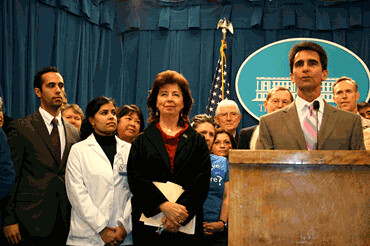"It would be nice if something made sense for a change." – Alice, from Alice in Wonderland.
Perhaps we live in an alternative universe.
One in which two thirds of Americans want the government to guarantee healthcare for everyone, while the policy makers in Washington labor to craft a reform plan that caters first to the threats and demands of the insurance industry and the minority voices on Capitol Hill.
One in which the Senate Finance Committee plays congenial host to the insurance industry, the drug companies, and right wing think tanks and it's chairman Max Baucus can proclaim all options are on the table while slamming the door on the nurses and doctors — and arresting them when they speak out. Why? For advocating the most comprehensive, cost effective reform of all, a single-payer/Medicare for all approach.
One in which single payer is considered off the table inside the rarified airs of Congress, but when President Obama ventures into a town hall meeting with regular folks, the first question he is asked is:
Watch here:
http://www.youtube.com/watch?v=Q6d45duX_WU
And one in which Drew Altman, CEO of the Kaiser Family Foundation can ponder today about how baffling it is that the "experts" — presumably people like him who was given a seat at the table by Baucus — sees the world so differently than the vast majority of Americans struggling to survive a cruel, inefficient, and inhumane healthcare system:
The "experts" say the problem is too much "unnecessary" care. The public thinks too many people are being denied care they need.
The experts think costs are so high because consumers don't have enough "skin in the game" (i.e., we like to go to the doctor, get invasive tests, and endure long waits for care and high out of pocket costs). The public thinks the reason is "because drug and insurance companies make too much money."
The experts think health care information technology is a panacea to improve quality and cut costs. The public thinks it will probably increase costs (the Congressional Budget Office happens to agree) and are concerned about the privacy of their medical records.
The experts think we must have comparative research to limit future costs. The public thinks "insurers should pay even if their doctor recommends a treatment that has not been proven to be more effective than a cheaper one." (Imagine, getting the care you actually paid your insurance company to provide, what a concept)
But at a price, to our health, to the well being and financial security of American families, and to the cause of health care reform.
Or as Michael Lighty, national policy director for the California Nurses Association/National Nurses Organizing Committee put it:

